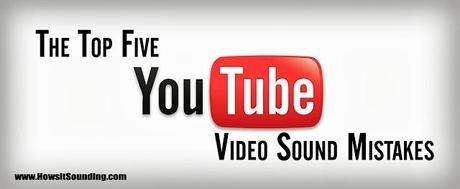
We have been at a technological point in our history for some time now where anyone can make a video and upload it to video sharing sites like YouTube. Many people have taken this opportunity to create “high quality” productions. Many people spend so much time focusing on how good the video quality is, they forget about the audio! I will now share with you what I find to be the top five audio mistakes for YouTube videos.
1. Pops and Click During TransitionsThis has to be one of the BIGGEST annoyances to me when it comes to video editing. This happens all too frequently, even in big budgeted projects. This is very over looked. For the most part, the art of long continuous camera shots and single takes are gone. Everything now is fast paced, and multi camera angles. A common YouTube video format is harsh edit points that trim off every conceivable second of unimportant video.
When people do this, they forget to add some type of audio fade between clips. Most video editing software allows a user to place an audio transition/crossfade right onto the end of an audio clip! There is no excuse to ignore this easy step! Not doing so will cause the audio waveform to be cut off in the middle of its data causing a very unprofessional pop or click.
Think of it as running your finger over a smooth and jagged piece of metal: your finger will gently glide over the smooth piece and be pleasing to the senses, but run your finger over the “unfinished” jagged piece, and your senses will be shocked as it cuts into your skin!
2. Clipping/Distorted AudioThis is something very common with people who are just starting out and have some “really cool” intro to their videos. You know these videos; they want to create drama and suspense, so they crank up the audio until the meter is stuck on red! RED IS DEAD!
When you are editing your video/audio, if you see your audio meters hitting red, please pull the audio down. Not only does it sound bad and unprofessional, but it will damage speakers over time. If you really want your sound as loud as it can be, then put a compressor and limiter on the audio track. Set the compressor to what you want, and set the limiter to -0.1db. That will give you the loudest sound without clipping.
In this example from the YouTube channel RatedRR, you can hear CLEARLY at 1:47 that the music is cranked up way to high. That’s sad, because this is a pretty professionally made video:
3. Improper PanningNow I don’t want to get into extreme nerdiness about how something may be panned a few degrees off, but what really gets me is a mono signal being sent to one speaker. Most microphones (that are not built into your camera) are going to be recording into mono, meaning one channel of audio, not stereo (left and right).
Lower end video editing software, improper audio encoding, and other reasons cause audio to potentially only be printed on one channel (usually the left). If you hear your audio coming only out of the left or right speaker, CHANGE IT! Usually this can just be fixed by changing your audio output to stereo or mono (in your editing software), panning the audio to the middle, or doubling up the audio and inverting the waveform.
In this example from Rockstar Energy Drink’s YouTube channel, at :36 seconds into the episode, the voice of Tanner Foust is panned too much to the left. It’s ironic because they show the audio team in the video:
4. Poorly Mixed LevelsThis happens a lot. Music these days is very compressed, meaning music doesn’t really get louder and quieter: it’s always loud. Movies have luckily stayed away from this. This is why when you watch a movie the action scenes are louder than the rest.
This should NOT be the case when you are making a simple tutorial video. If your into is ridiculously loud, but then when you speak, I have to crank my speakers up, something is wrong. This can be fixed by adjusting the audio level on your editing software, or by using a compressor to level out your audio.
5. Copyright InfringementUnfortunately, most people don’t even think twice about this. It is so tempting (and so easy) to make a video, and put your favorite song in the background of it. It sounds great right? Well, it’s illegal.
You can’t put any song or sound effect (or any audio) you want in your video if you didn’t create it or have a license to use it. It may seem cool to your friends and the general public, but it won’t seem cool to someone who has deep pockets and good lawyers once they realize that your video is not generating them income even though the song they own the rights to is in it.
There are TONS of royalty free music available for purchase at low costs and even some sites that offer free music downloads. It may be thirty dollars to you now for a song, but it could save you THOUSANDS in the future if you are caught.
ConclusionIf you want your video productions to sound better regardless if they are on YouTube or not, then you should avoid making these five mistakes that happen all too often. If you do, you’ll already be way above the majority in terms of professionalism.

